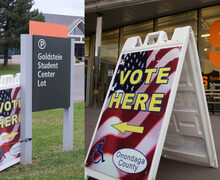Even with Sidibe’s return, Syracuse suffocated on the boards by Clemson
Courtesy of Bart Boatwright | The Clemson Insider
Alan Griffin battles for a rebound surrounded by Clemson players during Syracuse's 78-61 loss.
The Daily Orange is a nonprofit newsroom that receives no funding from Syracuse University. Consider donating today to support our mission.
It wasn’t anything new for Syracuse: the offensive rebounds that it surrendered, the positioning it couldn’t get on the blocks, the second chance points that inevitably resulted from those extra shots. On an SU team that’s had multiple problems surface throughout the season, rebounding was the problem, head coach Jim Boeheim reiterated numerous times.
He mentioned it after a game against Rutgers, then Pittsburgh, then UNC, then Pittsburgh again. The Orange lost all of those games. Boeheim even mentioned it after SU defeated Miami, then on weekly radio shows and conference calls.
And Saturday against Clemson, the latest example, that problem looked like Clyde Trapp missing his initial shot on the second possession, maneuvering around Marek Dolezaj down low and converting his layup. It looked like eight offensive rebounds in the first half. It looked like a 17-rebound margin after Trapp corralled Joe Girard III’s missed free throw and dribbled out the final seconds of the game.
By the end of the first half, Clemson had turned its extra offensive possessions into 18 second-chance points. Syracuse (10-6, 4-5 Atlantic Coast) had 10 rebounds total after 20 minutes, and it went the first five minutes without tallying one. The 25 rebounds across all 40 were its fewest this season and its fewest since Feb. 26, 2019 against North Carolina. In the Orange’s worst offensive performance of the season — one that will be defined by the 12% shooting percentage in the first half and Clemson’s suffocating defense — it was another rebounding disadvantage that contributed to their dismantling.
“Rebounding is a problem,” Boeheim said. “Has been a problem and will probably be a problem.”
At times this season, defensive collapses or shooting lapses have covered up Syracuse’s lack of rebounding. It entered Saturday’s game allowing an offensive rebound on 32.3% of possessions this season, which ranked 309th in the country, per KenPom. An efficient offense that found success in transition in early games evaporated when those breaks couldn’t start.
“We’re good in transition, but it’s hard to get in transition when you’re not rebounding the ball,” Boeheim said earlier this season.

Syracuse had only 10 rebounds total after 20 minutes. Courtesy of Bart Boatwright | The Clemson Insider
There was a chance that problem could ease away with the return of Bourama Sidibe, the Orange’s center who was out since the season-opener with a torn meniscus. It wouldn’t happen instantly, but rather gradually as he worked toward the role he abandoned with his injury. But even that didn’t surface against the Tigers, when he checked in with 12:46 left in the first half. Sidibe lacked the ability to out-jump and out-muscle Clemson’s players around the rim in his 11 minutes, and he didn’t record a rebound.
“He’s just not really ready to play yet,” Boeheim said.
That allowed the Tigers — which entered the game with a 26.4 offensive rebounding percentage, per KenPom, ranking 217th in the country — to capitalize. After Trapp secured the offensive rebound on their second possession, Aamir Simms snuck into the middle of the paint and recorded a put-back that gave Clemson its first lead.
“Get a defensive rebound there, we’re ahead,” Boeheim said, referencing the possession SU lost the lead it never gave back.
As Syracuse struggled to a season-low half of scoring, it grabbed six offensive rebounds — more than its five defensive rebounds — but struggled to convert those into points. Sidibe almost grabbed an offensive board after Guerrier missed a contested shot near the rim, but he couldn’t secure control, and the ball bounced out of bounds.
Simms rose for a corner 3-pointer with under seven minutes left in the first half, but his shot bounced off the rim. But Trapp grabbed possession, returned the ball to Simms and watched as the Clemson senior made the second shot. Nick Honor converted on the Tigers’ next possession, and Boeheim called timeout, with any chance at erasing a lead rapidly slipping away.
“We need to be more physical down low,” Dolezaj said. “They have a couple big guys over there, so we need to be more physical with them.”
The Orange kept the second-half rebounding margin to four, led by Guerrier and Griffin grabbing three apiece, and scored seven of their 18 second-chance points. But Dolezaj recorded just four rebounds total, often struggling to win, and maintain, position in front of Clemson players on defense.
After reaching double-digit rebounds in five games last year, he’s reached that number just once — Syracuse’s second game against Niagara. At one point, Boeheim said the Orange’s guards needed to contribute more on long rebounds and help Dolezaj. Other times, the blame rested inside, where teams such as the Tar Heels had more size than SU.
It’s all added up to the never-ending rebounding problem that’s plagued Syracuse throughout its season, a problem that’s part of the reason why the Orange are on the NCAA Tournament bubble as ACC play enters its final stretch.
But after 16 games, perhaps the greater problem is that Syracuse hasn’t found a solution.
Published on February 6, 2021 at 7:16 pm
Contact Andrew: arcrane@syr.edu | @CraneAndrew






